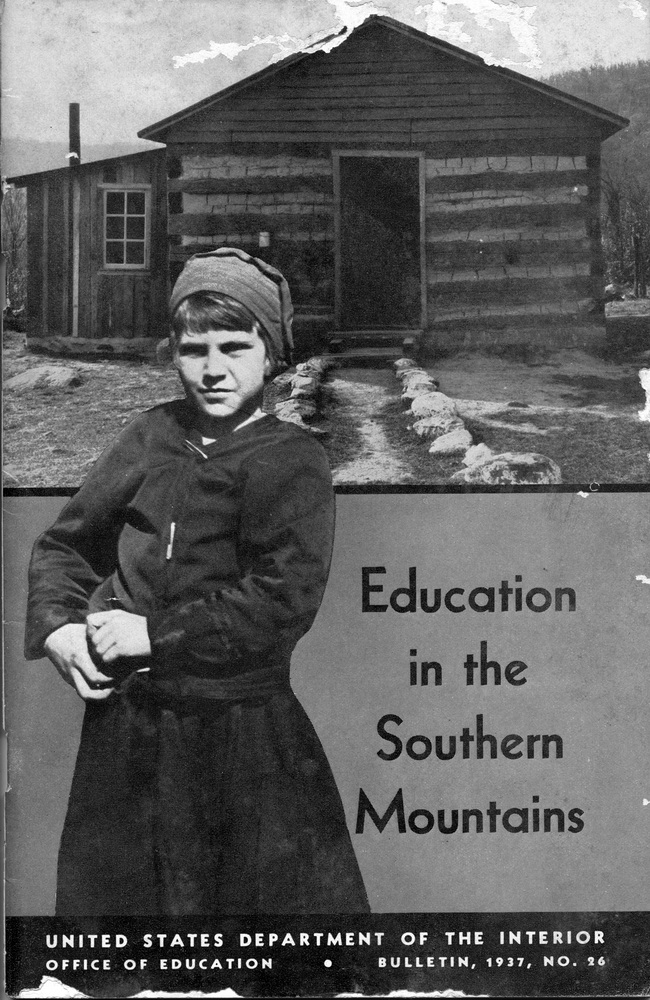EDUCTION IN THE SOUTHERN MOUNTAINS:
|
| * |
| Pages # |
I.D.#
edu_so_mt_ |
Description |
Thumbnail |
| cover |
cover |
[Cover] Education in the Southern Mountains
United States Department of the Interior
Department of Education
Bulletin 1937, No. 27 |
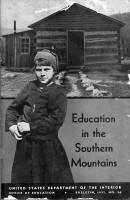 |
| Foreward |
|
FOREWORD The mountain area of the Southern
States has recently aroused unwonted attention on the part of the people
of the United States. That economic conditions were unsatisfactory; that
social services, including education, were wholly inadequate; and that
these conditions, with the isolation prevalent in mountain sections,
combined to set the people of these areas apart from normal farming
communities, has long been a matter of common knowledge.
Definite undertakings looking toward rehabilitation on a region-wide
scale were not, however, until recently, seriously contemplated. The
Federal Government, in the establishment and maintenance of the
Tennessee Valley Authority, has now entered the region with plans for
reconstruction of at least a large part of the area on an extensive
scale. Interest in education, as perhaps the most important of the
social services so long inadequate, motivated this study of educational
conditions in the area. It is believed it will serve a useful purpose in
furthering plans for continuing the improvements in social conditions,
now so auspiciously begun, through providing authentic information not
hitherto available.
Bess Goodykoontz,
Assistant Commissioner of Education. |
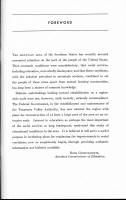 |
| Title page |
|
[Title page] U.S. DEPT. OF
THE INTERIOR, Harold L. Ickes. Secretary
OFFICE OF EDUCATION. J.W. Studebaker, Commissioner
Education
in the
Southern Mountains
Prepared by
W.H. Gaumnitz,
Senior Specialist in Rural Education Problems
Revised and edited by
Mrs. Katherine M. Cook,
Chief division of Special Problems
BULLETIN 1937, NO. 26
U.S. GPO, WASHINGTON, DC 1938
price 15 cents |
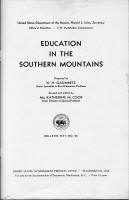 |
| Contents |
|
CONTENTS
PageForeword____________________________________________
Chapter I. Introduction____________________________________________ 1
The Southern Highlands—A favorite theme of news and fiction
1
Extent and character of the Southern Highlands ____________
3
Ability to support schools_____________________________ 4
Social and economic conditions________________________
6
Chapter II. School Conditions in the Southern Appalachians_________ 9
Plan of the study____________________________________ 9
The educational problem in terms of numbers_______________
12
Availability and accessibility of schools—A general view_______
14
Proportion of children attending school____________________
14
Elementary and secondary school enrollments_______________ 15
Area per school in square miles and transportation
expenditures. ___ 17
Some measures of the amount and quality of
schooling ___ 19
Grade levels attained_________________________________ 19
Length of school term and days attended_______________________ 21
Illiteracy__________________________________________ 21
Age-grade status of pupils_________________________________ 22
Qualifications of teachers______________________________ 24
Financial measures of educational opportunities
27
Average annual expenditures_______________________________ 27
Value of buildings, grounds, and school equipment_______________ 29
Estimated taxable wealth available for the support of schools_______
32
Financial aid for schools from State sources_______________
32
Human resources as a factor in school support________ _________ 34
Availability of schools in selected mountain
counties 36
Plan and purpose of this phase of the study__ __________________ 36
Location and distribution of schools__________________________ 38
Distances children live from school___________________________ 40
Relationship of school attendance to availability___ ______________45
Chapter III. Denominational and Independent Nonpublic
Schools. 47
Introductory statement________________________________ 47
Types of nonpublic schools_________ ___________________ 47
Curricular offerings_______________________________________49
Nonschool educational activities_________________________ 50
FIGURES
I. Location and expanse of the Southern Appalachian Mountains and
the counties selected for special study
_ 3
II. Location and accessibility of schools, 1932, Lumpkin County, Ga_
37
III. Wolfe County, Ky___________________________________ 39
IV. Macon County, N. C_________________________________ 40
V. Monroe County, Tenn ______________
41
VI. Mercer County, W. Va____________________________ 43 |
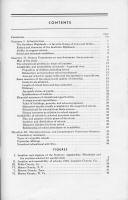 |
| 01 |
001 |
EDUCATION IN THE SOUTHERN
MOUNTAINS
CHAPTER I
INTRODUCTION
The Southern Highlands— A Favorite Theme of News and Fiction
According to an author and
student of mountain life, there is no section of our country of which
there is "so much known that is not true" as of the Southern Appalachian
Mountain regions. Much of what is "known" about the southern hill
country, its inhabitants, and their education, is derived from fiction
and colorful newspaper and magazine articles. In order to captivate the
interests of the public or to arouse a desire to do something about
prevalent conditions, writers dealing with such problems naturally
portray the unusual and the extreme. The discovery in 1929, for example,
of an isolated mountain community in which educational opportunities
were still undeveloped suddenly became the subject of picturesque
accounts spread far and wide by press and rostrum. Yet school conditions
for the county as a whole of which this particular hill community was a
part, were generally good. The people of the United States have drawn
from such sources and episodes the general and often mistaken idea that
the conditions portrayed in these unusual localities are typical of the
southern mountains as a whole.
A mountain worker recently voiced his complaint of
this mistaken attitude toward this area as follows:
For many years the southern mountaineer has been the butt of much
highbrow ridicule. He has been scandalously misrepresented and often
shamefully maligned. There are two main reasons for this treatment.
What the outside world has known about us in the past has been
gained from reading books and magazine articles whose scenes are
laid in our mountains. The writers of these books have painted the
mountain people as being feudists and moonshiners ; as ignorant
people living in fearful squalor and degradation; as descendants of
criminals in whose bloody footsteps they still follow; as
ignoramuses who resent the least appearance of anything
|
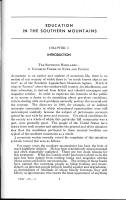 |
| 02 |
002 |
modern. Mountain books, short stories, novels,
pictures, plays, and collections of ballads galore have recently
appeared—nearly all of which are of an unsympathetic nature. The authors
of these productions chose to write about exceptional and isolated
cases, or imaginary cases, and brand them, without warrant or excuse, as
typical mountain conditions.[1]
Although fully recognizing the tendency of popular writers to depict the
extreme and thus to overdraw the picture, it is, nevertheless, true
that school conditions in the southern mountains constitute a difficult
problem. Reliable accounts of the type quoted below, calling attention
to the neglect and failure to bring educational opportunities worthy of
the term to such communities, could be multiplied:
Unattractive and uninviting though this bleak little school building
may be, to the mountain folk it brings a contact with the outside.
Within, the barrenness was somewhat dispelled by bright pictures
adorning the walls. But even their cheerfulness could not conceal or
counteract the meagerness of furnishings and equipment; no teacher's
desk or chair, no shelf or drawer for books and supplies, five desks for
some score of children, four rough benches (one serving as teacher's
chair and desk), a blackboard limited to one wall, a map of the world
(Mercator's projection), a defective stove, a water pail, and a wash
basin.[2]
* * * Those of us who are working in schools on the secondary level
appreciate the reasons that have caused our boys and girls to be poorly
prepared for the work of the standard high school. We know that in
literally thousands of the one-room schools throughout the mountain
counties the children do not have textbooks. In Kentucky alone 30
percent of the boys and girls in the rural schools last year were
without textbooks; in many schools not more than 10 percent were
provided with schoolbooks. In these same schools there are no
supplementary readers, no charts, no maps, no material for educational
seatwork. The blackboards are so slick one can scarcely make a mark with
a piece of chalk, and pieces of old felt hats are still used for
erasers. Under such conditions we find great soul hunger and little food
with which to satisfy that hunger. It is perfectly apparent that boys
and girls, whose educational opportunities have been such as these, have
not had a fair start in life. Their retardation is easily understood.
Those of us who work in these schools, those of us who have studied
the educational problems of this section in comparison with those of
other sections know that in the mountain counties boys and girls do not
enjoy equal educational opportunities.[3]
[1]
[2]Hitch, Margaret.
Life in the Blue Ridge Hollow. Journal of Geography, 30:
309-323, November 1931
[3] Baird, W. J.
Education. Mountain Life and Work, vol. IX, no. 2, July
1933.
|
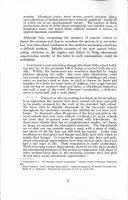 |
| 03 |
003 |
Extent and Character of the Southern Highlands
The area designated as the Southern Mountains is composed of a variety
of communities. The region recognized in a recent social and economic
survey of the Department of Agriculture[1]
as the Southern Mountain area and considered in this bulletin, embraces.
[MAP]
205 counties. It lies within six States- Georgia, Kentucky, North
Carolina, Tennessee, Virginia, and West Virginia. (See fig. 1.) Smaller
sections of Maryland, South Carolina, and Alabama are frequently classed
as belonging to this general area but these units are not included in
this study. The total area comprises 55,375,580 acres. It is larger by
far than any of the six States of which the Southern Mountains are a
part and is greater in area by 13,000,000
[1]
Economic and Social Problems and Conditions of the Southern
Appalachians. Washington, U. S. Department of Agriculture,
1935. (Miscellaneous Publication No. 205.) pp. 1-2.
|
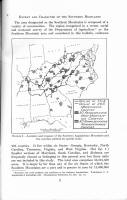 |
| 04 |
004 |
acres than all the New England States
combined. Its greatest length is about 500 miles; its greatest width 200
miles. The total area has a population of nearly 5,000,000. As a whole
the region is sparsely populated. Low population density, as will be
seen later, is one of the chief difficulties to be met in providing such
social services as public education. While sparsity of population is
characteristic of the area there are two cities, namely, Chattanooga and
Knoxville in Tennessee, each with more than 100,000 population. Six
other cities, namely, Clarksburg and Charleston in West Virginia,
Roanoke in Virginia, Asheville in North Carolina, Johnson City in
Tennessee, and Ashland in Kentucky, have populations ranging between
25,000 and 100,000. There are several other cities such as
Charlottesville and Bristol in Virginia; Bluefield, Fairmont, and
Morgantown in West Virginia; and Rome in Georgia, each of which has a
population of more than 15,000. Moreover, there are within the area
county seats and minor industrial centers with populations ranging
between 2,500 and 15,000. In the urban centers the educational services
and facilities are as a rule as well developed as in other urban
communities of the Nation.
Ability to Support Schools
In many communities in the more sparsely settled mountainous
sections, facilities for public education are inadequate or entirely
lacking. In large parts of the area the farms are extremely small. In
1930 almost one-half of the farms in this highland region were less than
50 acres in area. Fully one-third were less than 20 acres. Their size,
lack of fertility, hillside location, and eroded condition make for low
incomes.
Data are available from a variety of sources showing the prevailing
situation. The Department of Agriculture survey states:
On more than 50 percent of the 383,870 farms, the farm value of all
farm products sold, traded, or used by the farmer's family was under
$600 per farm; on about 30 percent the value per farm was under $400. In
about 18 percent of the minor civil divisions comprising the Southern
Highlands the average value of the farm products traded or sold was
under $200 and in about 3 percent it was under $100 per farm.5
The amount given represents the gross production of the farms
studied. More than 40 percent of the farms in the region were
classified as self-sufficing, meaning that the value of the products
used directly by the farm family was equal to or greater than the value
of all crops, livestock products, forest products, or other farm
products sold or traded during the year. In other words, on two out of
every
s Ibid. p. 41.
|
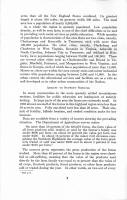 |
| 05 |
005 |
five farms all of the commodities produced were
necessary to supply the immediate needs of the family, leaving no cash
with which to purchase the "all else"
[1] so essential to a good
life. Moreover, the products available are so limited in variety, if not
in quantity, as to afford subsistence farm families only a low standard
of living. Table 1 shows the average income of farmers of the mountain
counties compared with that of all counties within the respective
States. If certain mountain counties were separated from the group
average for comparison, the value of production per farm would be even
less. According to a study of a group of representative mountain
families in Kentucky, "the total cash income * * * amounted to less than
$45 per family * * * the average dwelling house was worth $110 and the
entire capital, including land, buildings, livestock, tools, and other
items of equipment was $551.[2]
follows:[1]
[TABLE]
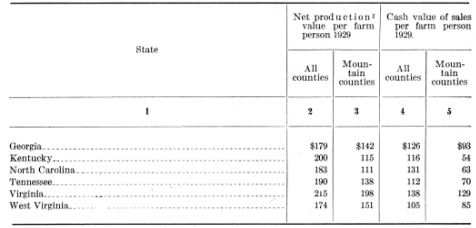
In our immediate sections the average (annual) income of the small
farmer is between $85 and $90. The farmer has, of course, his garden and
his land from which he gets most of his living, but $90 does not offer
much margin for taxes, clothes, books, education, seeds, fertilizer,
etc. For a single trip from the county seat we pay the doctor $7. * * *
The topography and history of the mountain country explain why over
large areas our elementary schools have been very poor. While they are
improving greatly,
[1]
Campbell, Mrs. Olive D. Adjustment to rural industrial change with
special reference to mountain areas. Proceedings of the
National Education Association, 67: 484-88, 1929.
|
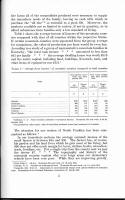 |
| 06 |
006 |
they are still very inadequate. As a result we have a
large population which, if not actually illiterate, is very limited in
education. This population presents a special educational problem of
which we hear much, and which must always be considered, but which
cannot be considered apart from the economic and social phases of
poverty * * *. Evidence presented later in this study indicates
that the taxable wealth on which schools draw in large part for support
is less adequate in mountain than in the nonmountain areas (see p. 32)
of the same States. A number of studies comparing State tax resources
indicate that the Southern States[1]
which include the mountain area are generally less able economically to
support schools than those in certain other sections of the country.
Since both local and State sources of income are inadequate as compared
with other areas, the mountain
[IMAGE]

Home on the Road to Old Rag, Virginia
section appears to have a double handicap from the point
of view of school support.
Social and Economic Conditions
The causes of backward social and economic conditions in the southern
mountain areas have been discussed widely by many authors and need not
be considered at length here. Conditions have been rapidly changing
during the last 25 years. Improved
[1]
Financing public education, Washington, National Education Association,
1937. (Research Bulletin, vol. XV, No. 1.) |
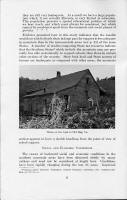 |
| 07 |
007 |
schools, public and private; roads; hospitals; telephone
and telegraph lines; electric lighting; and modern home conveniences are
among the influences now overcoming isolation and social backwardness.
The program and activities of the Tennessee Valley Authority 10 have
recently given encouragement to the people of the southern mountains.
Efforts are being made through its Division of Social and Economic
Development to study the resources of the area, develop its
potentialities, and plan a program of action. This program is designed
to improve the general social and economic welfare of this section of
the Nation, as well as to exclude from cultivation the portions
undesirable for the maintenance of homes and community life. The effects
of these changes upon education should be significant.
In an intensive study of 428 representative families living in the
mountain areas of eastern Tennessee, eastern Kentucky, and western
[IMAGE]

Home of family of 10 which has been on relief for 18
months.
North Carolina, Prof. Lester R. Wheeler
[1] gathered data showing
changes during the past 25 years in the home, community, and economic
life of the southern mountaineer. He concluded that during these years
the average mountain family has decreased in size from
i° Meyer, Walter E.
The Tennessee Valley looks to the future. Journal of the National
Education Association, 23: 233-48, December 1934.
[1]
Wheeler, Lester R. A study of the remote mountain people of the
Tennessee Valley. Journal of the Tennessee Academy of Science, 20:
January 1935.
|
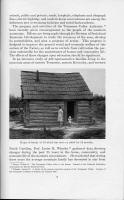 |
| 08 |
008 |
about 10 members to 8; that the average mountain home
has changed from a "one-room and lean-to-structure'' to a two-story,
frame building of five rooms; that the very limited stock of home-made
furnishings has been replaced by factory-made furniture, including a
sewing machine, a victrola, and a clock; that in every 100 families the
number of home owners has increased by 4, the number of renters has
increased by 6, and the number of squatters has decreased by 10; in
place of one cow per family which constituted the average possession in
livestock in 1910, practically every family now has two cows, a hog or
two, and several chickens; wagons and trucks have largely supplanted the
wooden slip-drags and the horse and the automobile have to a large
extent supplanted travel on foot. Where travel by train was practically
unknown 25 years ago, 67 percent of the mountain people now report
having ridden on a train. The influence of more and better schools is
seen in the increase of the family library from the Bible and an almanac
in 1910 to 32 volumes, a weekly or monthly magazine, a fountain pen and
ink in 1935; improvements were also noted in such basic things as home
sanitation, the place of women in society, and the general standards of
living. The study summarizes the situation by pointing out that the
social and economic status of the average mountain home of 25 years ago
closely resembled the lower 10 percent of those found in that region
today. It appears probable, therefore, that the extreme conditions
commonly depicted by the literature dealing with the southern mountains
represent accurately only the lower 10 percent (according to the author
just quoted) of the homes and communities of this region and not the
average. However, this estimated percentage involves a large number of
boys and girls for whom the presence or absence of an opportunity for an
education is a matter of real importance. It is the purpose of this
study to present data to show educational conditions both in the more
backward mountain communities and in the southern mountain regions
generally. |
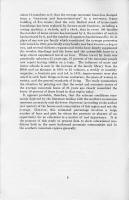 |
| 09 |
009 |
CHAPTER II
SCHOOL CONDITIONS IN THE
SOUTHERN APPALACHIANS
Plan of the Study
This chapter presents the following information concerning
educational conditions and efficiency of the school systems: (1) The
average educational practices in the five counties of each State which
are generally regarded the most mountainous and consequently present the
greatest difficulties in the development of public education; (2) the
average educational practices in five representative counties in the
non-mountainous area of each State; (3) the average educational
practices in all of the counties of each of the States commonly regarded
as forming a part of the Southern Appalachian area; and (4) the average
educational practices in each State as a whole. It is apparent that the
total mountain region of each State contains all gradations of
mountainousness and that the averages for the total mountain counties
will include the data for the most mountainous counties. Also the
averages for the States as wholes include both the most mountainous and
the non-mountainous counties.
A comparison of conditions among type areas in each State will
indicate the extent to which mountain conditions have retarded
educational developments. The comparisons will, of course, not be as
sharp nor will the differences be as great when the measures are reduced
to averages for groups of counties as if data for each county were
presented separately.
The statistics in this section were gathered in part from the
published reports and files of the six State departments of education
which exercise jurisdiction over the schools of the area. In some cases
statistical adjustments in the data available were essential in order to
secure comparability. In a few instances, additional data were gathered
directly from the schools.
The data employed are for the most part for the school year 1929-30
and pre-date the period of the depression. However, other studies of
educational changes indicate that the scaling down of such public
services as education has been fairly proportional between mountain and
non-mountain communities, the poorer school districts suffering somewhat
greater reductions. The differences between the educational situations
in 1929-30 and now are not, therefore, as great as one might |
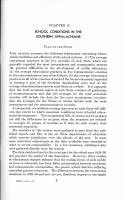 |
| 10 |
010 |
expect. Ordinarily school conditions do not vary greatly
from year to year. The 1929-30 data have the advantage of being
comparable to the data published by the United States Census Report, a
source frequently drawn upon in this study. (The data deal with
educational conditions among white persons unless otherwise indicated.)
Scope and Setting of Survey.—The names of the entire group of
mountain counties as well as those of the counties selected to represent
the most mountainous and the non-mountainous sections are as follows:
[TABLE] |
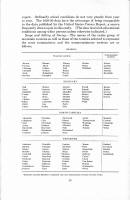 |
| 11 |
011 |
[TABLE] The counties constituting the total
mountain area included in this study are marked out with a heavy broken
line on a map of the southeastern quarter of the United States. (See
fig. I.) On this map are shown, through distinctive hatchings, the
location of the five counties selected to represent the most mountainous
sections, as well as the five counties selected to represent the
non-mountainous areas of each State. The former were selected from a
group ranked by school officials from each State as areas which are most
mountainous and in which mountain conditions definitely influenced
educational development. The latter were selected at random, care being
taken that one county in each State contained one of the larger urban
centers and that all non-mountain sections of each State were
represented.
The six States with which this study is concerned constitute an area
of 253,617 square miles (see table 2), 85,356 of which are included in
the area known as the Southern Highlands. About two-thirds of this area
is in three of the States—West Virginia, Virginia, and Tennessee.
The area within the Tennessee Valley Authority is outlined in figure
I. It includes 23,477 square miles, or 27.5 percent of the total
Southern Highlands. More than three-fourths of the mountain section of
Tennessee and about one-half of that of North Carolina are included
under the Valley Authority. |
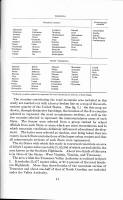 |
| 12 |
012 |
[TABLE] THE
EDUCATIONAL PROBLEM IN TERMS OF NUMBERS
The first aspect of
education in the southern mountains to be examined here concerns the
number of children of school age living within the area. The age groups
as given in the table roughly correspond to the periods of elementary
and secondary education. (See table 3.) In the 205 mountain counties of
the six States, slightly more than a million children 7 to 15 years of
age and somewhat fewer than half a million of those 16 to 20 years of
age live. From the standpoint of potential school attendance,
therefore, approximately a million and a half boys and girls are
involved—nearly 40 percent of the children of the designated age groups
in the six States. About half as many children of school age live in the
most mountainous as in the non-mountain counties. The differences are
particularly marked in Georgia and in Tennessee.
The
data presented in table 3 show also the distribution of the youth by age
groups in the mountainous and non-mountainous sections of these States.
The proportion of children 16-20 years of age to the total group is
considerably greater in the latter than in the former, the differences
being greatest in Tennessee and least in Virginia. This indicates the
tendency of older children to forsake the mountain communities to find
homes and occupations elsewhere. The differential is not affected by
persons attending schools away from home because the children were
enumerated where they reside rather than where they attend school. The
general tendency for children of the post- |
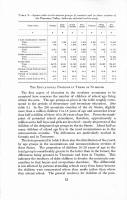 |
| 13 |
013 |
elementary school ages to leave the mountain communities
is more evident when the factor of sparsity is considered than when
population data only are compared. (See table 4.) The natural sparsity
of population in the mountain counties and the tendency of the children
to leave home early together constitute one of the chief difficulties in
making suitable school facilities available, particularly for
secondary-school children. Of course it is possible that if better
educational opportunities were accessible, the mountain child
[TABLE]
would not leave home so early. |
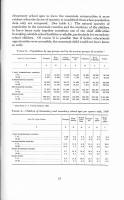 |
| 14 |
014 |
Availability and Accessibility of Schools—A General
View Perhaps the most important consideration relating to school
conditions in the southern mountains is the question of whether or not
there are schools available within reasonable distances of the
children's homes. The factors involved in this question are many and
complex.[1]
Comprehensive information concerned with school accessibility is not
available. Data which provide certain significant indices are, however,
presented as indicative of the situation. They concern the proportion of
children of school age enrolled in school; the comparative enrollments
in the elementary and secondary grades; the average number of square
miles per elementary and per secondary school; and the per-pupil
expenditure for transportation.
Proportion of children attending school.—The proportion of children
of school age enrolled in school is considered a practical measure of
school availability. If the proportions in each of the several age
groups compare favorably with those in other communities, it may be
assumed that schools are available. However, evidence of enrollment
does not necessarily mean that the schools are readily accessible or
that the children attend regularly. In table 5 data are presented
showing percentages of persons attending school in the several types of
areas for the age groups 7-15, 16-20, and 21 years and over,
corresponding roughly to the periods commonly associated with the
elementary school, the high school plus junior college, and college
plus any organized efforts in the field of adult education,
respectively. In order to get an index of school enrollment for the
entire school age group, the total number of children 7-15 years of age
and those 16-20 years of age were combined and percentages found for the
proportion reported to have been in school in each type of community
studied.
These data indicate that of the children 7 to 15 years of age, the
period most closely affected by the compulsory attendance laws,[2]
from 5.7 to 19.7 percent failed to attend school during the school year
indicated. For the counties representing the most mountainous sections
of these States, the proportions not enrolled in school ran consistently
higher than those of the representative nonmountain counties of the same
States. In the mountain counties of Kentucky, nearly one of every five
children of elementary school age failed to enroll in school; attendance
in the nonmountain counties of this State was 12.6 percent higher than
the average for the mountain
[1]
Cook, Katherine M., and Gaumnitz, W. H. Availability of schools in
rural communities. In the Status of Rural Education. Bloomington,
111., Public School Publishing Co., 1931. (National Society for the
Study of Education, 30th Yearbook, Part I.)
Gaumnitz, W. H. Availability of public-school
education in rural communities. Washington, Government Printing
Office, 1931. (U. S. Department of the Interior, Office of
Education, Bulletin 1930, No. 34.)
[2]
The compulsory laws of Kentucky, Tennessee, and West Virginia
require the attendance at school of all children 7-16 years of age;
Virginia, 7-15; North Carolina, 7-14; and Georgia, 8-14.
|
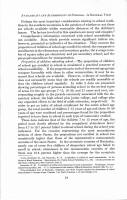 |
| 15 |
015 |
counties, closely paralleling the percentages in the
same age group in the non-mountain sections of the other five States
studied. The non-attendance was more than 10 percent in the most
mountainous counties of all of the States except West Virginia.
[TABLE]
Of the children 16-20 years of age in the mountain sections of the
several States, approximately two-thirds did not attend school during
the period. This compares fairly closely with percentages found for
these Southern States as wholes, as well as with percentages for the
entire Nation. But when the percentages for the most mountainous and the
non-mountainous counties are compared, substantial differentials may
again be noted in favor of the latter, West Virginia again providing the
exception. Among persons more than 20 years of age, the percentages show
relatively small differences among the various types of areas.
The differences between the percentages for the most mountainous and
nonmountainous sections of the various States are less marked among
older children. They are no doubt able to walk greater distances. Those
going to colleges no longer travel daily the distance from home to
school. Moreover, some of the schools for pupils of high-school age are
boarding schools, especially in the more mountainous sections. Private
and philanthropic enterprises make a great effort to bring older persons
from the more backward communities into contact with educational
opportunities.
Elementary and secondary school enrollments.—Accessibility should
|
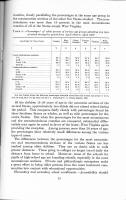 |
| 16 |
016 |
be considered also
from the standpoint of the grade level attained. Data presented in table
6 show that only a small proportion of children of the more mountainous
sections are enrolled in high school. While
[IMAGE]
School consolidation and accessibility
must contend with roads like these.
the figures upon which these percentages are based do not include
data from the missionary and philanthropic schools, it does not seem
probable that the inclusion of children enrolled in them would
materially alter the situation |
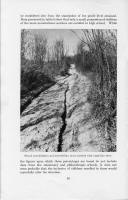 |
| 17 |
017 |
In every State the non-mountain counties show much
larger percentages of the entire public-school enrollments attending
high school than the mountain counties. If all the children old enough
to attend the last 4 years of the public schools were enrolled in these
grades, the percentage should approximate 30. That this percentage is
seldom reached is indicated by the fact that the Nation's schools as a
whole average only 17.1 In city school systems it tends to approach more
closely the maximum than in rural communities. This fact accounts
largely for the 30.6 percent of the school population found in high
school in the non-mountain counties of Georgia. Fulton County, Ga.,
contains the city of Atlanta, in which enrollment in high school is high
compared to that in other areas of the State. Comparatively few of the
children in school in the most mountainous
[TABLE]
counties, particularly in Georgia, Kentucky, or Virginia, attend
high school, unless they go to nonpublic schools or schools outside of
their home counties. Opportunities for secondary education are probably
not available in the home counties. While fairly high percentages of
those 16 to 20 years of age are attending school (see table 5), many are
evidently still in the grades, and are either marking time because no
high schools are available or are retarded.
Area per school in square miles and transportation expenditures.—
Further evidence that the opportunity to obtain a secondary school
education at public expense is not generally provided in the most
mountainous sections of these States may be found in the data showing
the average area per high school (see table 7). It seems reasonable to |
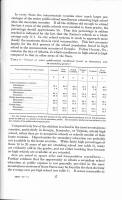 |
| 18 |
018 |
assume that, barring the use of boarding and
transportation facilities as means of overcoming distance from school,
the average area served by the secondary school of a given community
should not be much greater than the area served by the elementary
school. The areas per elementary school are, therefore, likely to
represent closely the maximum attendance areas of the high schools. It
may be noted (see table 8) that in the mountain counties comparatively
little money is spent for pupil transportation, thus indicating that the
accessibility of the schools provided is not materially improved through
this means. And, so far as is known, provisions are seldom made from
public funds to pay the board of pupils who attend high school away from
home. If, therefore, the basic assumption is granted, it is clear from
the data presented that comparatively wide areas of the most mountainous
counties
[TABLE]
are not within reach of schools offering high school work. |
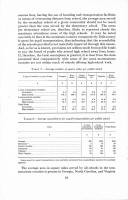 |
| 19 |
019 |
than in the mountain counties of these States. However,
the non-mountain counties in these States show unusually large
expenditures for pupil transportation. In the other three States the
average areas vary comparatively little for all schools. The area per
high school is, however, considerably greater for the mountain counties
of all six States than for the nonmountain counties. In Kentucky and
Tennessee the average area per high school is nearly twice and in
Georgia more than three times as great in the most mountainous counties
as in the nonmountain counties. Even if the secondary schools were
centrally located and if the children could travel to and from such
schools in a direct line "as the crow flies", those living farthest away
would obviously have to travel long distances to school. In the most
mountainous counties of Georgia, for example, the distance might be more
than 6/2 miles each way. High schools in the mountain counties are as a
rule in villages not often located in the geographical center of the
respective counties. Moreover, the more mountainous the area, the more
likely it is that a given point can be reached only by a circuitous
route. Although the data presented thus far are somewhat general and
indirect in character, they indicate that public schools, especially
high schools, are not as available in the mountain as in the nonmountain
areas of the States in question and that inaccessibility is more serious
in the most mountainous counties. It also appears that many children of
high-school age attending school are still in the elementary grades.
Some Measures of the Amount and Quality of Schooling
Grade levels attained.—Table 9 presents data concerned with the grade
levels to which the children in the different types of areas are
retained in school. Taking the third grade as representing 100 percent
attendance, percentages were computed which show the extent to which the
children are still in school when the sixth grade, the first year of
high school, and the last year of high school, respectively, are
reached. The third grade is used as a basis because, by the time the
child reaches this grade, he is normally 8 or 9 years of age. He is old
enough to withstand the hardships entailed in traveling reasonable
distances to school and not old enough to be kept home for work or to
stay away from school because he thinks himself too grown up to attend.
The data indicate that there are about two-fifths as many pupils in
the sixth grade of the schools of the most mountainous counties of
Kentucky as in the third grade. In the non-mountain counties of the
State fully two-thirds of the pupils are retained to the sixth grade. |
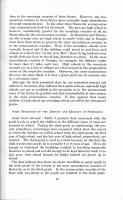 |
| 20 |
020 |
In Tennessee and Virginia also the percentages of pupils retained to the
sixth grade are higher in the non-mountain counties. In North Carolina,
however, a larger proportion of pupils of the most mountainous counties
stay in school to the sixth grade than in the non-mountain counties.
Ratios of enrollments in the first year of high school to those in the
third
[TABLE]
grade are higher in the non-mountain counties of all the States.
Indeed, comparisons for both the first and last years of high school
show the effect of mountainousness upon pupil retention. If the data
presented in table 10 are representative, there are whole mountain
counties in the six States in which only about two of five children
receive as much as a sixth-grade education. Even the best of the more
mountainous counties seldom keep more than three-fourths of the children
through this grade. With the exception of West Virginia and North
Carolina, the schools of the more mountainous counties lose at least
three out of every four children before they reach high school and only
one-fourth to one-half of those who enter high school remain until the
last year. The non-mountain counties of these States, other than West
Virginia, retain about twice as many to high-school entrance and hold a
much larger proportion of the children until they reach the fourth year
of the secondary school.
Generally speaking, the schools of each of the six States as a whole
consistently show better records in retaining pupils to the higher
grades |
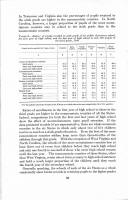 |
| 21 |
021 |
than the mountain sections. For the high-school levels
the differences are for the most part marked. The highest percentages
retained in school, even in the nonmountain areas, are considerably
below those found for the Nation as a whole. Some States in which the
schools are developed beyond the average would, of course, show
retention indices higher than those for the Nation as a whole.
Length of school term and days attended.—Two indices of the amount of
school education provided in the mountain communities are the number of
days per year schools are open and the number of days the pupils
actually attend school. Data presented in table 10 give information of
the types indicated. They may be read as follows: In the five most
mountainous counties of Georgia the elementary schools are open an
average of 141 days per year; in the five nonmountain counties they are
open 179 days—nearly 2 months longer. In the former the pupils attend on
an average 98 days annually and in the latter 142 days. The actual
period of instruction received by the average child in the most
mountainous counties of Georgia is nearly 9 weeks shorter each year than
in the non-mountain counties. In at least three of the States the
disadvantage of short terms in the most mountainous counties is
aggravated by irregular attendance.Illiteracy.—Two types of
illiteracy data are discussed in this study. (See
[TABLE]
table 11.) The illiteracy of persons 10-20 years of age may be
thought of as the present responsibility of the schools. The illiteracy
of persons older than 20 may be regarded as evidence of the past failure
of the schools. The fact that the percentage of illiterates |
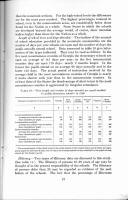 |
| 22 |
022 |
shown for the younger age group is in every case very
much lower than for the older group, indicates that a greater effort is
being made than formerly to achieve some education. [TABLE]
Data for both age groups are favorable to the non-mountain counties.
In the most mountainous counties of Kentucky, Virginia, and Tennessee,
approximately 1 in 20 of the children of school age were reported as
illiterate in 1930; of those over 20 years of age in the most
mountainous counties of 4 States, more than 1 in 10 were unable to read
and write. There is some evidence that the more backward communities are
now improving more rapidly than the non-mountain sections. In any event,
the data presented in table 11 do not show as much illiteracy in the
most mountainous sections as the general reports from these regions
would lead one to expect. Due to the high literacy rate of Fulton
County, containing the city of Atlanta, the non-mountain area of Georgia
is the only type area included in this study in which the illiteracy now
"in the making'' is lower than that of children 10 to 20 years of age
for the Nation as a whole. The non-mountain counties of four of these
States, however, show a smaller percentage of white adult illiterates
than the average for the Nation. In all but one case, the illiteracy
percentages of the six States, taken as wholes, are considerably higher
than those for the Nation.
Age-grade status of pupils.—A measure commonly used as an index of
the effectiveness of schools is the age-grade status of the pupils.
Assuming that a child 6 or 7 years old should be in the first grade, one
7 or 8 years old in the second grade, one 8 or 9 years old in the third
grade, and so on, table 12 shows that the percentages of children |
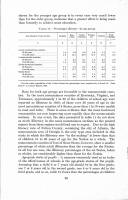 |
| 23 |
023 |
who are above normal age for their grades are higher in
the most mountainous counties than in the non-mountain counties of the
respective States. Retardation is apparently nearly as great a problem
in the high school as in the elementary grades. No data wholly
comparable are available for the Nation as a whole, but a sample study,
based upon data for 1927 [1]
involving 116,651 white pupils in the elementary grades of 70
representative city schools located in 35 States, showed 13.4 percent
over age; another study made in 1928
[2] of 7,632 pupils in the
elementary grades of 45 representative consolidated schools showed that
15.2 percent of the children were a year or more retarded; still another
study made in 1930,[3]
including both elementary and secondary schools located in the rural
communities of 22 counties of 5 representative States, showed that of
the 52,574 pupils involved, 17.6 percent were 1 or more years retarded.
Table 13 offers additional data concerning retardation. It should be
read as
[TABLE]
follows: 64 percent of the 10-year-old children of the most
mountainous counties of Kentucky are retarded. Of these, 23.6 percent
are retarded 1 year; 21.1 percent, 2 years; and 19.3 percent, 3 or more
years. In the no-nmountain counties of this State, 37.8 percent of the
10-year-old children are retarded; 19.4 percent, 1 year; 10.9 percent, 2
years; and 7.5 percent, 3 years or more. It is significant to
[3]
Gaumnitz, W. H. Availability of public education in rural
communities. Washington, Government Printing Office, 1930. (U.
S. Department of the Interior. Office of Education, Bulletin 1930,
no. 34.)
5 Blose, D. T. An age-grade study of 7,632
elementary pupils in 45 consolidated schools. Washington,
Government Printing Office, 1930. (U. S. Department of the Interior,
Office of Education, Pamphlet No. 8.)
[1]
Blose, D. T., and Segel, David. The school life expectancy of
failures in the elementary grades. American School Board Journal,
March 1933.
|
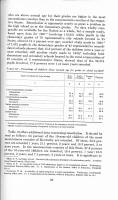 |
| 24 |
024 |
note that the differences between the percentages for
the two types of communities become greater as the number of years of
retardation increases. The proportion of the children retarded as well
as the number of years they are retarded is considerably greater among
the 14-year-olds than among the 10-year-olds. Not only are larger
proportions of the children retarded as they become older, but the
number of years the average child is retarded increases as he becomes
older. These facts probably account to a considerable degree for the
comparatively small number of pupils shown by table 9 to reach the
upper grades of the school. There is a tendency for retarded children to
become discouraged and leave school. [TABLE]
Qualifications of teachers.—Educators generally agree that the most
important factor in school efficiency is the teacher. Other things being
equal, the teacher most thoroughly trained should be the most
successful. It follows that the quality of the education provided by
the school is to a degree determined by the amount of training the
teachers have received. In order to examine this aspect of the education
provided in the southern mountains, data are presented (see table 14) to
show, first, the proportion of the teachers serving these schools who
have high-school education or less and, second, the proportion who have
2 years or more of college education. Those in the first group are
above |
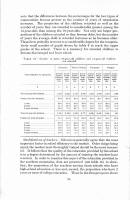 |
| 25 |
025 |
the level of the general population of these
communities, but inadequately trained for teaching. The second group
have training now widely accepted as a minimum standard for teaching
certificates. [TABLE]

[IMAGE]

Mountain school and teacher's cabin.
With the exception of West Virginia, the differences between the
training of the teachers of the most mountainous counties and of those
of the non-mountain counties are favorable to the latter. (See table
14.) In the most mountainous counties of Georgia and Kentucky, for
example, more than three-fourths of the teachers have a high-school
education or less. In the former, the percentage of teachers |
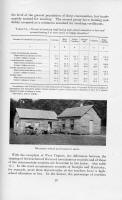 |
| 26 |
026 |
with this training is more than seven times as great in
the most mountainous counties as in the non-mountain counties. In
Virginia the percentages of such teachers in all types of areas are
smaller than in any of the other States, but in the most mountainous
counties the proportion is nearly six times as great as in the
non-mountain counties. In the non-mountain counties of the States
having the best record in teacher preparation a considerable proportion
of the teachers are comparatively unprepared and nearly one-half fall
below the accepted standard of 2 years of college education. The recent
oversupply of teachers is resulting in raising the certification
standards and consequently in lowering the percentages of undertrained
teachers. While comprehensive comparative data are not available,
progress along this line in the most mountainous counties appears to be
less satisfactory than in the non-mountain counties as indicated in the
table.
Experience is usually also considered an important measure of the
efficiency of teachers. Studies of experience as a factor in teaching
efficiency verify the general observation that especially during the
first 5 years of service in the schools a teacher gains in knowledge and
skill through professional reading, contacts with fellow teachers, and
similar types of experiences. Although the differences are
comparatively small, the percentages (see table 15) show clearly that
in all of the six States, except Virginia, the schools of the most
mountainous counties employ a larger proportion of beginning teachers
than those of the non-mountain counties. Conversely, the non-mountain
counties of all but West Virginia attract and hold a larger proportion
of experienced teachers. A study of 150,182
[1] teachers employed in
1930 in schools located in centers of 2,500 or fewer population in the
United States revealed that 17.4 percent were teaching their first year,
while 68.4 percent had taught 3 or more years. For the most part, the
available data show that stability of the teaching force does not differ
widely in the six States from that in the Nation as a whole. The slight
advantage shown by some of these States in this respect would probably
disappear entirely if, as in the Nation-wide study, data from city
schools were excluded.
Another factor which determines to some degree the quality,
training, and fitness of the persons employed as teachers is the salary
paid. The average annual salaries of teachers and supervisors of the
various types of counties in 1930 are shown in table 16. The average
teacher employed in the most mountainous counties of Georgia was paid
$436 per year; in Kentucky, $510; in Virginia, $588; in North Carolina,
$654; in Tennessee, $716; and in West Virginia, $988. The salaries are
[1] Gaumnitz, W. H. Status of
teachers and principals employed in the rural schools of the United
States. Washington, Government Printing Office, 1932. (U. S. Department
of the Interior, Office of Education, Bulletin, 1932, No. 3.) |
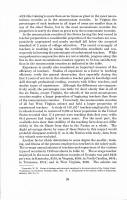 |
| 27 |
027 |
higher in the nonmountain counties in all States. Omitting Georgia, the
differentials range approximately from $250 to $400.
table 15.-— Percent of
teachers new to the profession and those having 3 or more years of
experience, 1930
[TABLE]
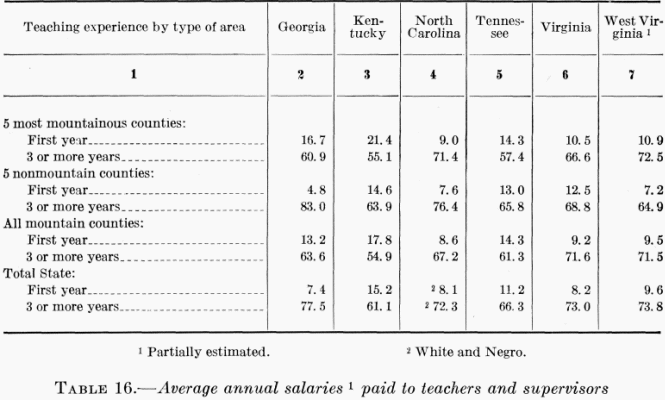
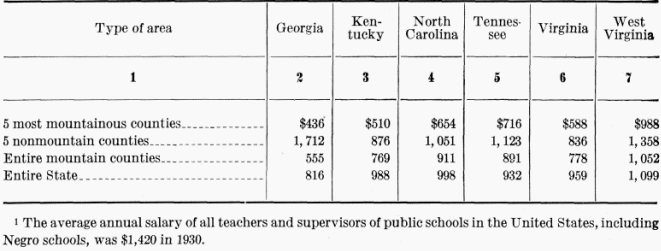
financial measures of educational opportunities
Average annual expenditures.—When the educational opportunities
of two or more communities are compared from a financial viewpoint, two
major considerations are: The amount spent annually to support the
public-school program; and the money invested in housing and material
equipment. To secure measures whereby the various groups of counties may
be compared, annual expenditures for the public schools for whites,
except funds invested in new sites, buildings, and equipment, were
totaled by counties and by groups of counties. (See table .17.) These
were then divided (1) by the total number of white teachers employed in
the schools, (2) by the number of white children
|
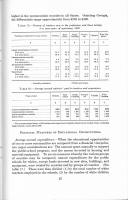 |
| 28 |
028 |
6-20 years of age living in the respective counties, and (3) by the
number of pupils enrolled in the public schools for whites.
[TABLE]
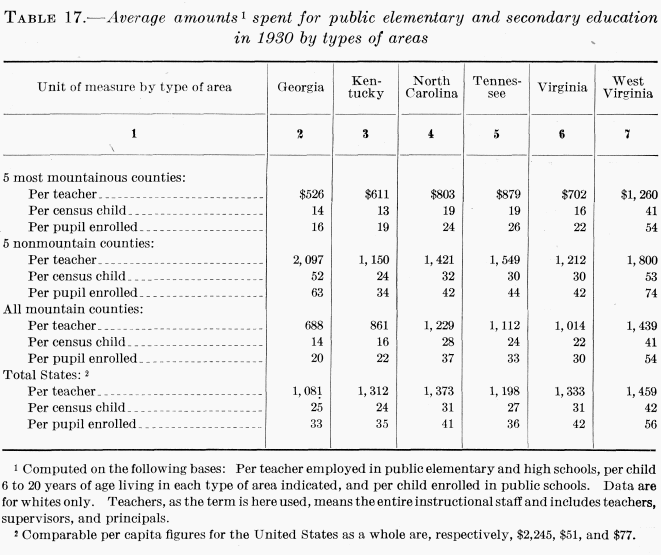
While each type of divisor
has its own peculiar significance as a measure of the amount and quality
of education provided, the annual per-teacher cost is probably the best
of the three measures of financial support in a given community. It
overcomes somewhat the differences due to sparsity of population. In
one-teacher schools it is roughly equivalent to all the money spent for
school purposes.
The measure of comparative costs most commonly employed in the United
States is the average expenditure per pupil. Since this measure does not
consider the children of school age who live in a given area but are not
attending school, the per-capita costs were computed also on the basis
of all children 6-20 years of age who live in each group of counties as
given by the United States census report. The three types of data are
presented in table 17.
Great variations in public-school expenditures among the States and
between similar types of communities are shown in the table. In each
case, except for the non-mountain group, Georgia shows the lowest annual
expenditure for public education; West Virginia the highest. The schools
of the most mountainous counties of Georgia and Kentucky spent less than
half as much on education as those of |
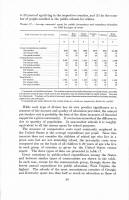 |
| 29 |
029 |
West Virginia. Insofar as greater expenditures mean
better schools, comparisons between the most mountainous and the
non-mountain counties reveal significant differences in favor of the
latter. The differences in expenditures shown are from 45 percent higher
in West Virginia to nearly 300 percent higher in Georgia. When
comparisons are made to the United States as a whole, even the highest
average expenditure found in these six States falls below the national
average. Value of buildings, grounds, and school equipment.—Data to
show the amount of money per teacher and per child 6-20 years of age
invested in school buildings and sites and in permanent school
equipment are presented in table 18. The value of school property
reported by local school officers is in part estimated. However, it is
believed that the counties in question follow the same method of
determining and reporting the amount of money invested in school
property. The data are therefore assumed to be comparable among the
several States.
[IMAGE]

Certainly they permit comparison between the groups of counties
within each State. In the case of West Virginia separate data for white
and Negro schools were not available for either the value of school
buildings and grounds or for the equipment. Hence the data presented for
this State are for both races. The same is true of equipment values
recorded for Kentucky.
The five most mountainous counties, as well as the mountain counties
as a whole within each State, have apparently invested comparatively
little in school buildings and equipment. If it is assumed that the
averages for the non-mountain counties represent the amount a community
should invest in school buildings and equipment, it may be concluded
that the more mountainous groups of counties fall far short of the
need. In Georgia, for example, the most mountainous |
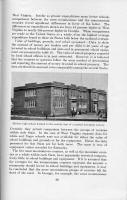 |
| 30 |
030 |
counties report an
average investment in buildings and grounds of less than $800 per
teacher as compared to more than $5,000 in the non-mountain counties—a
ratio of 1 to 6. In Kentucky the most mountainous counties show an
investment less than one-fourth that of the non-mountain counties. In
Tennessee and West Virginia the difference is less striking. But even in
these States the non-mountain counties have invested nearly 1 % times as
much money in school buildings and grounds per unit of measure as the
most mountainous counties. The entire mountain counties of the several
States, with the exception of Tennessee, show consistent and marked
disparities when the average values of school buildings and grounds are
compared with those of the
[TABLE]
 |
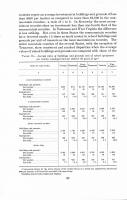 |
| 31 |
031 |
States taken as wholes. Compared on the per-child basis,
the differences are greater than on the per-teacher basis. Generally
speaking, both in the value of school buildings and grounds and in the
amount invested in school equipment, the mountain counties fall below
State standards as well as below those maintained in the non-mountain
counties of the respective States. When national averages are taken as
standard, these shortcomings of the mountain schools are still more
apparent. Averages do not, of course, show extreme conditions. In some
communities visited there were no public-school buildings; church
buildings and benches were used for school purposes. Equipment consisted
of the few books and materials the children brought from home or which
were provided through the resourcefulness of the teacher. Many public
schools observed in the remote mountain communities are plain square
buildings in poor repair, containing very little equipment.
Under the local system of financing public education, widely
practiced in the United States, the presence or absence of educational
services, and the conditions of the schools in general, are found to
bear a very close relationship to the wealth of the communities in which
they are located.[1] Since
the economic conditions of the southern mountains are below standard,
the school buildings and equipment provided are also unsatisfactory.
Estimated taxable wealth available for the support of schools.—Some
idea of the differences in taxable wealth among the types of
communities in the States studied may be obtained from table 19,
showing the estimated wealth per teacher employed and per child 7 to 20
years of age. The data include figures for both whites and Negroes.
The differences between the average estimated wealth per teacher for
the most mountainous and the non-mountain counties are for the most part
significant. The differences are somewhat less when computed on a
per-child basis than when computed on a per-teacher basis. A comparison
of the average expenditures and the per capita wealth suggests that the
several groups of mountain counties levy slightly higher taxes for
school purposes than the average of the respective State of which each
is a part. Similar comparisons between these States and the Nation
reveal, however, that school tax rates are somewhat lower in the six
States than in the Nation as a whole.
Financial aid for schools from State sources.—It is of interest in
this connection to note the extent to which schools in the States
studied draw upon State funds to supplement or equalize the funds
available for school purposes from local tax resources. Information is
presented to show the amount of money contributed to the public schools
from State sources computed on the basis of the number of teachers em-
They Don't Pay Taxes. Journal of the National Education Association,
21: 259-61,
[1]
Cowden, Susie E. November 1932.
|
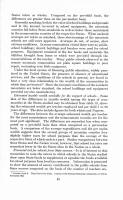 |
| 32 |
032 |
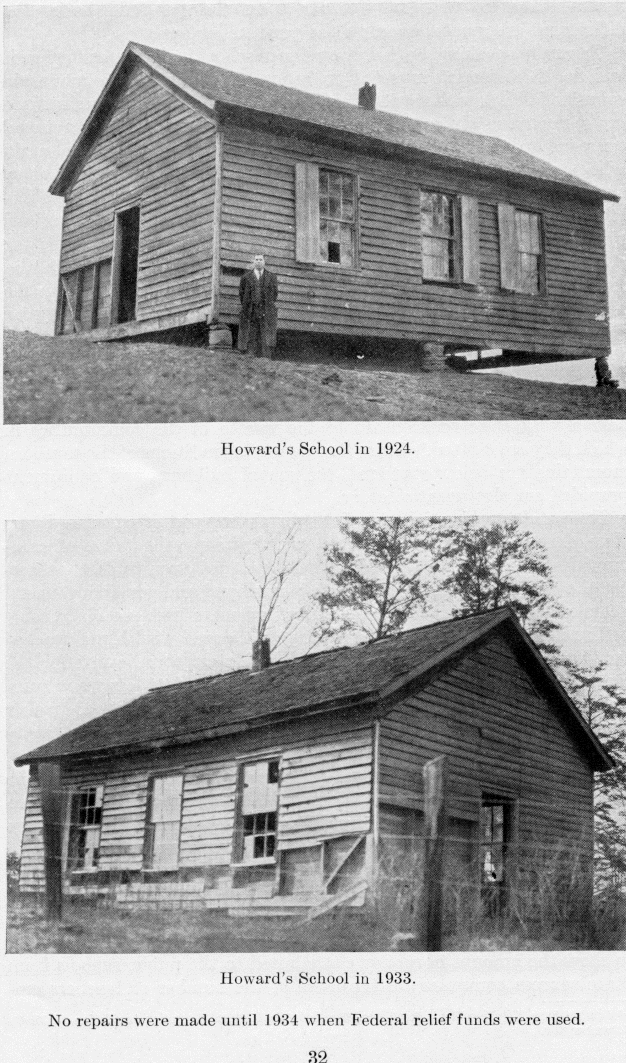 [IMAGE]
[IMAGE] |
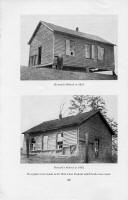 |
| 33 |
033 |
ployed and on the basis of the number of children 7-20
years of age living in the various counties. (See table 20.) [TABLE]
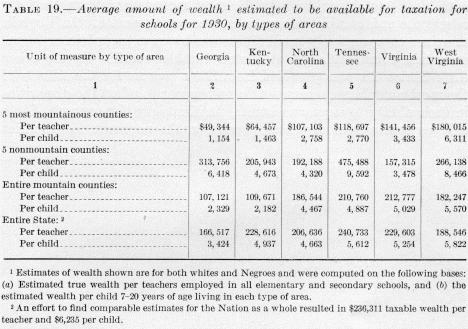
In West Virginia, North Carolina, Tennessee, and Georgia an effort is
being made through state aid to off-set the limitations of the
[IMAGE]
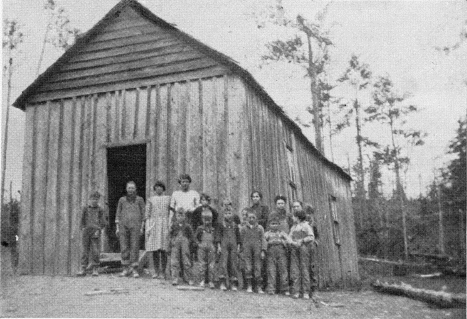
Abandonment of old clap-board buildings |
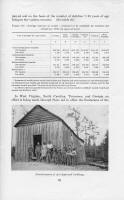 |
| 34 |
034 |
mountain counties due to inadequate taxable wealth. In
West Virginia, and probably also in North Carolina, the favorable
differential in State aid enjoyed by the most mountainous counties
fully offsets the unfavorable differential in per-capita wealth. In
Virginia there are comparatively small differences between mountain and
non-mountain communities in estimated taxable wealth. In the other three
States the aids provided from State sources for the schools of the most
mountainous counties do not appear to offset the disparities in their
ability to support schools. In Kentucky, for example, State aid per
capita is, if anything, greater in the non-mountain counties despite the
fact that the per-capita wealth is more than three times as great
[IMAGE]
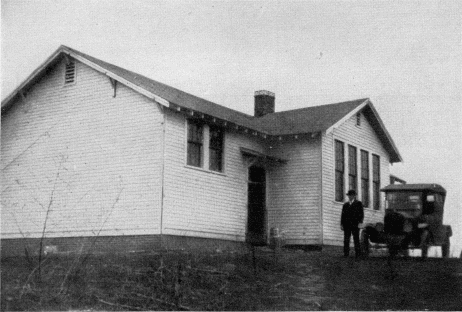
Replacement by new consolidated schools
as in the five most mountainous counties.
In recent years much progress has been made in the equalization of
the educational opportunities through the use of State funds; West
Virginia, North Carolina, and Tennessee are examples. If comparative
data were available showing State aid in mountain and non-mountain
counties for a date later than here presented, changes in the situation
would probably appear in these States.
Human resources as a factor in school support.—The ratio which the
number of adults 21 years of age and older bears to the number of
children and youth to be educated is sometimes considered as a factor in
a community's ability to support schools. Table 21 shows the |
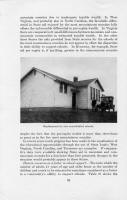 |
| 35 |
035 |
[TABLE]
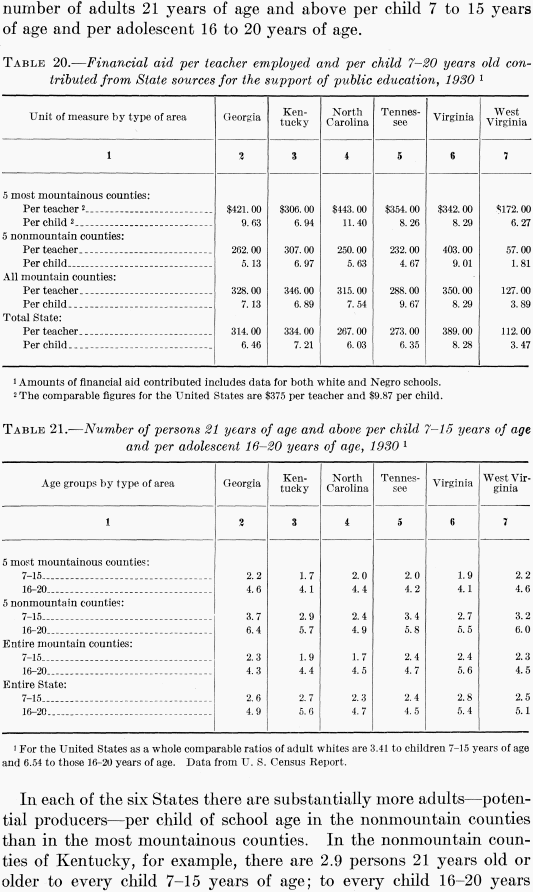 |
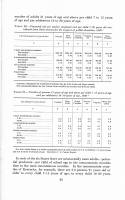 |
| 36 |
036 |
old, 5.7 adults. In the most mountainous counties,
however, the ratios are 1 child to 1.7 adults for the younger group of
children, and 1 to 4.1 adults for the older group. In the non-mountain
counties of this State there are, therefore, 1.2 and 1.6 adult producers
more per child of elementary school and high-school age, respectively,
than in the mountain counties. Georgia and Tennessee show very similar
disparities. If the effects of this factor on. the inequality in ability
among the various types of counties to support an adequate school
program are added to those previously mentioned, the lack of
educational progress is more easily understood. Rupert B. Vance
[1] points out the
significance of this factor in his study of the relationship of regional
resources and human adequacy when he calls attention to the fact that 11
of the Southern States, with less than one-quarter of the Nation's
population, have fully two-fifths of the Nation's children to rear and
educate. If only the children living on farms are considered, it appears
that the rural areas of these 11 States now rear and educate nearly
two-thirds of all the farm children 5-20 years of age of the United
States.
Availability of Schools in Selected Mountain Counties
Plan and purpose of this phase of the study.—In order to get a
close-up view of the whole question of the accessibility of schools in
the Southern Appalachians, a detailed study was undertaken of a number
of selected mountain counties. Data are here presented in the form of
county maps (see figs. II to VI and tables 22 to 25), which are
supplemented with statistical data collected directly from individual
schools. The five counties named below, with the State in which each
is located, furnished the information necessary for this part of the
study: Lumpkin, Ga.; Wolfe, Ky.; Macon, N. C.; Monroe, Tenn.; and
Mercer, W. Va. These counties may be thought of as fairly typical of the
most mountainous sections of these five States. They represent,
therefore, those parts of the mountain areas in which the problems of
making public educational opportunities readily accessible to all of the
children are the most difficult.
Factual data presented in this section were collected directly from
the schools and the county superintendents of the counties in question.
The purpose is to provide, by way of illustration, answers to the
following questions: Just how many and what kinds of schools are there
in the most mountainous counties? How are they distributed over the area
to be served? How far are the elementary schools from each other? The
high schools? How far do the children live from the
[1]
Vance, Rupert B. Human Geography of the South. University of
North Carolina Press, 1932. (University of North Carolina Social
Study Series.)
|
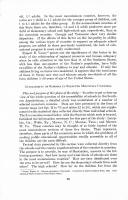 |
| 37 |
037 |
[MAP]
 |
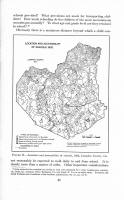 |
| 38 |
038 |
are: The time required and the effort expended in
traveling to and from school. These vary with climate, topography, road
conditions, the age of the child, cooperation of parents and the like.
In surveys of city school systems, the practice followed in certain
recent studies is to fix one-half mile as the maximum distance a child
should walk to school. The maximum distance fixed in studies made by
rural educators and by the compulsory education laws of most of the
States is usually either ll/2 miles or 2 miles. A maximum of 2 miles is
the basis used for purposes of this section. Location and distribution
of schools.—The schools within the five counties were located on the
county maps as accurately as possible, with the help of the county
superintendents, and a circle drawn around each school upon a 2-mile
radius. No home within a given circle is more than 2 miles from the
school located at its center. The actual distance children walk to
school may, of course, be greater. Mountain roads tend to wind in and
out with the valleys and creeks. Precipitous mountains often act as
barriers. Even where there are areas of fairly level country, the route
from home to school will seldom follow a straight line.
The circles placed around the schools, together with the symbols
showing that they serve the elementary or the secondary grades, or both,
will afford some idea of the distances the schools of various types are
from each other. (Figs. II to VI.) The schools are usually located in
valleys and on bottom lands. In areas in which the contour lines are
farthest apart, indicating little change in elevation, the circles
overlap considerably; in areas in which the contour lines are close
together, indicating mountainous terrain, there is comparatively little
overlapping. Indeed, parts of the more mountainous areas are not
included in any of the circles, indicating that such areas are located 2
miles or more from the nearest schools. The small circles, squares, and
other symbols locating the schools, and the numbers within these
symbols, show that almost all of the elementary schools are of the 1-
and 2-teacher type. The high schools usually employ three or more
teachers, indicating that they serve as central schools for several
elementary school districts. In Lumpkin County, Ga., for example, there
is only one high school in the entire county.
Transportation to either the elementary or the secondary schools is
provided in comparatively small portions of these communities. One
reason for the absence of transportation is that roads in the more
mountainous sections are as a rule undeveloped. Where school bus routes
are maintained, peculiar markings have been placed on the maps to
indicate whether they serve the elementary pupils, the high-school
pupils, or both. Lines paralleling the few existing bus routes were also
marked out to show the territory located within 1% miles |
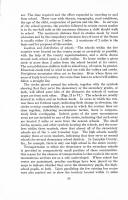 |
| 38 |
039 |
of these routes, the assumption being* that children who
live within 1 ji miles of such routes may be thought of as being
accessible to the schools to which these bus routes lead. Symbols are
used to show white schools, Negro schools, and nonpublic as well as
public schools. Although these circles show that, even in these more
mountainous counties of the Southern Appalachians, the number and
distribution of the schools are such as to place practically all areas
within 2 miles
[MAP]
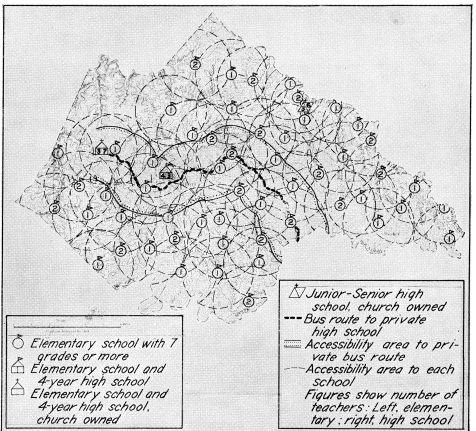
Figure III: Location and accessibility of Schools,
1932, Wolfe County, Ky.
of some sort of an elementary school, there are areas in each county
which fall outside of these circles. In Lumpkin County, Ga., and Macon
County, N. C, nonschool areas are comparatively numerous and large.
Mercer County, W. Va., on the other hand, has practically no such areas.
The question of whether children of school age live within the areas
outside the circles is very important. If these areas contain no
children they are of little interest to us so far as the problem of the
availability of schools is concerned. Data were gathered directly from
representative schools within these counties to show |
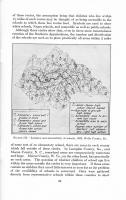 |
| 40 |
040 |
the actual distances the children live from their
schools. Most of the schools furnished information showing the distances
between home and school of both the children attending school (see table
22) and those of school age who are not attending school (see table 23).
It may be assumed that those reported as living more than 2 miles from
school live outside of the circles. The data given in the tables concern
only the children walking to school because provision for transportation
involves changes in the problems of school accessibility. Distances
children live from school.—In each of the five counties there are some
children both in and out of school who live more than
[MAP]

Figure IV: Location and accessibility of schools,
Macon County, 1932, N.C.
Distances children live from school.—In each of the five counties
there are some children both in and out of school who live more than 2
miles from the nearest schools provided. (Table 22.) Of those attending
school in these counties a total of 1,098, or 9.2 percent, live from 2
to 4 miles, and 143, or 1.2 percent, live 4 miles or more from the
school. Of the out-of-school children in the five mountain counties
there are 489 children living from 2 to 4 miles from a school and 48
living 4 miles or more; or in percentages, 30 and 2.9, respectively.
There is good reason to believe that many of the out-of-school children
were not reported by the schools and that the proportions unreported
vary directly with the distances they live from the schools furnishing
the information. If all of the out-of-school children were included |
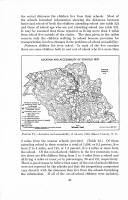 |
| 41 |
041 |
[MAP]
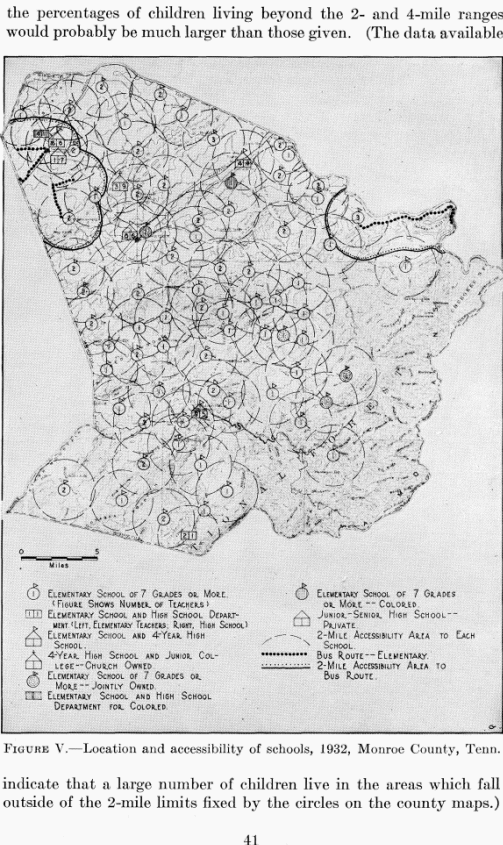 |
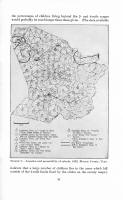 |
| 42 |
042 |
[TABLE]
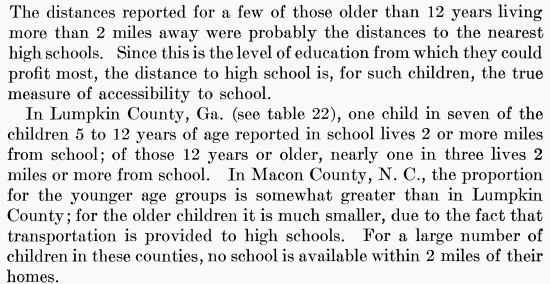
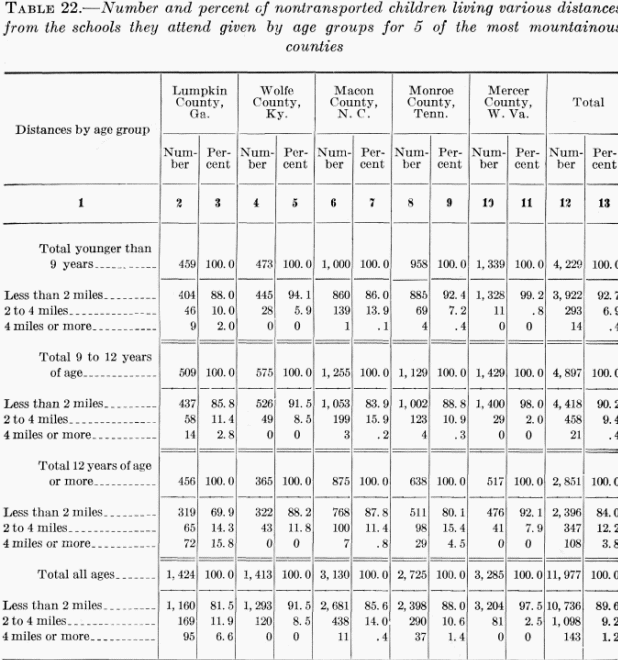
|
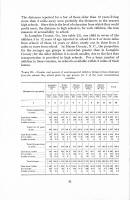 |
| 43 |
043 |
[MAP]
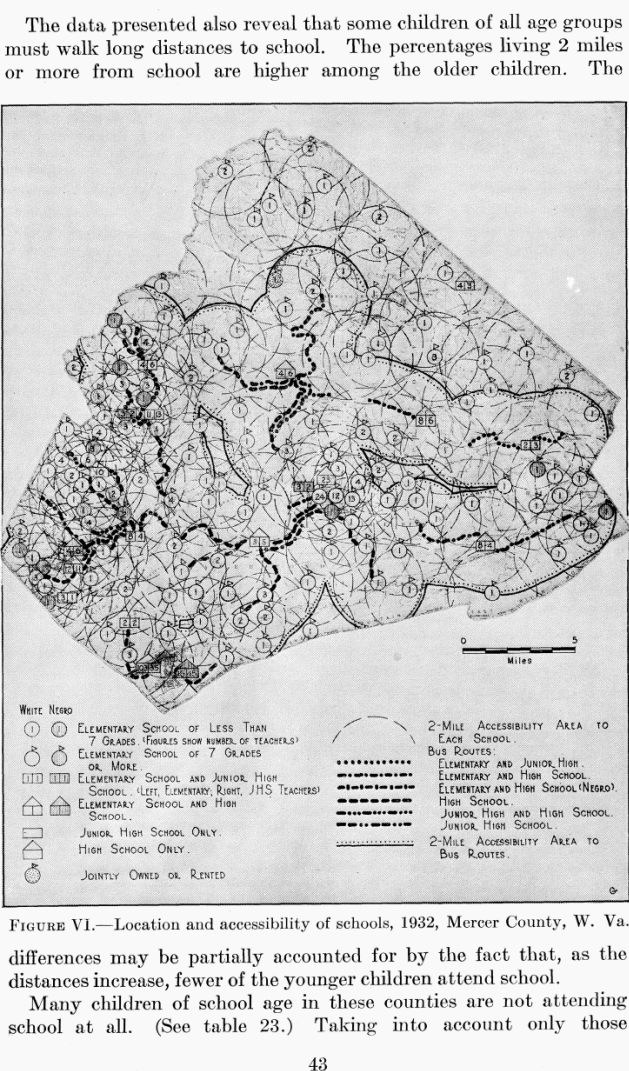 |
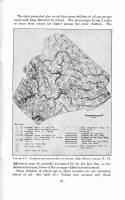 |
| 44 |
044 |
children who have at one time or another attended
school, data were secured for a total of 1,630 out-of-school children 5
to 20 years of age. Of these, 1,503 were 13 years of age or older. Most
of them had probably discontinued school. However, as will be seen in
table 25, fewer than half of them had reached the seventh grade before
leaving school; nearly a fourth had not gone beyond the fourth grade.
Nearly one-third of all of these out-of-school children live 2 miles or
more from school. In general the proportion of the out-of-school
children living long distances from school is greater than that of those
attending school. Many of the older out-of-school children living long
distances from school are most likely not in school because there are no
high-school facilities near their homes; others, as will be seen
presently, have because of the long distances and other reasons,
attended school so irregularly that retardation and lack of interest
have resulted in their discontinuing school before reaching high school.
[TABLE]
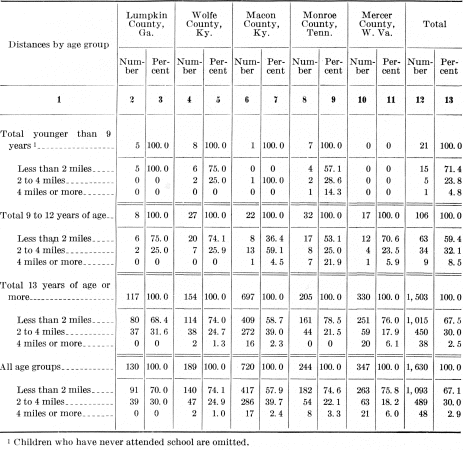
|
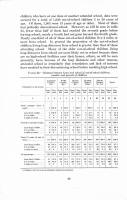 |
| 45 |
045 |
Relationship of school attendance to
availability.—Distance from school probably influences the number of
days per year and the total number of years children attend school as
well as enrollment. Tables 24 and 25 concern, respectively, the actual
number of days attended by the designated groups of 7,152 children in
school and the grade levels reached by 1,604 out-of-school children at
the time they left school. An examination of table 24 indicates
approximately two-thirds of the sampling reported attended school 130
days or fewer; two in seven attended 50 days or fewer. The median days
attended ranged from 90 in Wolfe County to 142 in Lumpkin County. Of the
sampling of out-of-school children reported (table 25) all but 100 were
13 years of age or older. Of the latter, approximately one-half were in
grades 3-6 when they last attended school; a few had been in grades 1-2
and the remainder had reached the seventh grade which probably was the
highest grade offered in many of these mountain schools. Both the poor
attendance and the fact that so many of the children fail to continue in
school beyond the sixth grade suggest pointedly the effects of long
distances and related influences. One recognizes the difficulties
involved in providing adequate school facilities, elementary and
secondary, to children living in remote isolated
[TABLE]
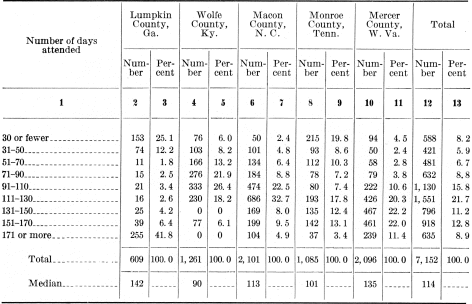
Table 24: Number and percent of non-transported
children attending school the number of days indicated during one year.
communities, especially when those resulting from sparsity of
population are aggravated by the presence of mountain conditions and an
inadequate economic basis of school support. A permanent solution
probably involves fundamental reorganization of the system |
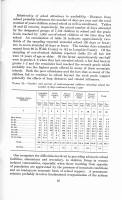 |
| 46 |
046 |
of administration and support in addition to
initiative on the part of officials responsible. While some of the
difficulties inherent in the physical conditions indicated may be
overcome by more immediate remedies such as adequate school funds and a
more practical program of studies complete solution will doubtless await
the reorganization indicated.
[TABLE]
Table 25. - Children of school age not attending
school classified according to age groups and highest grade levels
reached when last in school. 1
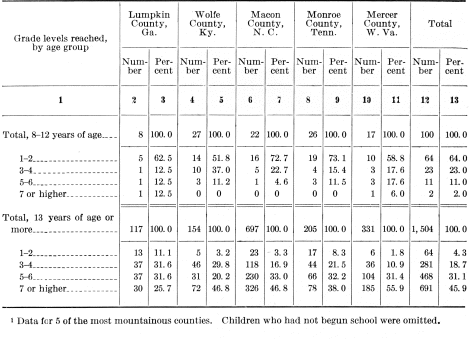
|
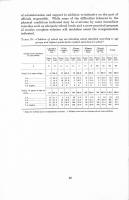 |
| 47 |
047 |
CHAPTER III DENOMINATIONAL AND
INDEPENDENT NONPUBLIC SCHOOLS
Introductory Statement
In many southern mountain communities where there are no public
schools, or in which for many years there were none, missionary and
other philanthropic organizations have established schools. Reliable
data showing how many children and youth are attending such schools are
not available. It is, however, well known that some of the
outstanding successes in providing an education suited to the needs of
these isolated groups must be credited to private and denominational
schools. One has only to think of such well-known institutions as
Berea College, of Berea, Ky.; the John C. Campbell Folk School,
of Brasstown, N. C.; the Asheville Farm School, of Asheville, N.
C; the Berry Schools, of Rome, Ga. Two excellent studies
[1] recently made of these
nonpublic schools describe and evaluate their services.
Types of nonpublic schools.—According to the studies indicated,
within the 205 counties constituting the mountain area included in this
survey in 1932 there were 162 nonpublic schools. Of these, 143
furnished information on the levels and types of education provided.
Fifty offered both elementary and secondary work and 44 elementary work
only, a few of these extending through the junior high school grades. A
total of 21 limited their program to the junior-senior or to the regular
high-school grades. Fifteen others offered junior college work and 12
more offered a complete 4-year college program. One, the John C.
Campbell Folk School, of Brass-town, N. C, rendered services to mountain
youth without regard to the graded system of education. About 85 percent
of these schools maintain dormitories. The majority, however, serve day
pupils from nearby homes as well as boarding pupils. From the data
showing the inaccessibility of schools in many of these mountain
communities it may be concluded that the opportunity to live at the
schools is an important service because it helps to overcome the
ever-present distance factor.
[1]
Dunn, Fannie W. Missionary and philanthropic schools. In Religion
in the Highlands, by Elizabeth Hooker, pp. 243-85, 300-16. New
York, The Home Mission Council, 1933.
Waller, E. C. A Survey of the Church and
Independent Schools and Colleges of the Southern Appalachians,
Knoxville, Tenn. The Author, 1410 Magnolia Avenue, 1931.
|
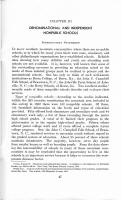 |
| 48 |
048 |
These schools are for the most part located in the more
undeveloped centers.[1] The
median distance from a paved highway, for example, is more than 4 miles
and the median distance to a large market or shopping center is nearly
20 miles. Seventy-nine percent of the schools are located in the smaller
villages or in the open country. In 56 percent of the cases the nearest
public elementary school is of the one-and two-teacher type. As a
rule, private schools were originally established in the poorer and more
isolated sections. However, it is pointed out by Dr. Dunn
[2] that at the present time
the relationship between the location of nonpublic schools and the
wealth of the communities is not always very close. The Blue Ridge
sections of Tennessee, North Carolina, and Virginia, for example, have
many of these schools, although the public-school systems, especially
the high schools of the counties in which such schools are located, are
often very much better developed than those of many of the mountain
counties in Georgia, Kentucky, and the mining sections of West Virginia,
which have few or none of the nonpublic schools. At the present time
many counties in which missionary and philanthropic schools are located
are better able to support public education than others in which no such
schools are maintained.
It is, however, becoming more and more common for the private schools
to discontinue all or part of their school programs as rapidly as public
schools are made available to serve the needs of the mountain
communities. There are a number of cases in which private school
authorities deed their property to public-school authorities upon
assurance that the property will be used for public-school purposes.
Cooperative relationships between these two types of schools are
growing in frequency. In some cases the public-school system maintains
the elementary grades and the private schools the high-school and
college grades; in others the public maintains the school and the
private school authorities provide dormitory and boarding facilities.
Sometimes the missionary agencies maintain teacherages and thus secure
the right to participate in selecting the teachers for the public
schools. Many other types of cooperation are found. Such cooperation,
undoubtedly, holds much promise for the future; though in some
localities the presence of private schools actually tends to delay the
proper development of the public-school program.
The purposes and functions of the nonpublic schools vary greatly, as
would be expected from the number and types of agencies upon which the
schools depend for support. The avowed purpose of many of them is to
make available to ambitious but needy boys and
[1]
Waller, E.G. A survey of mountain schools. Mountain life and
work, vol. VII, January 1932.
[2]Op.
cit. Religion in the highlands. Pp. 249-53.
|
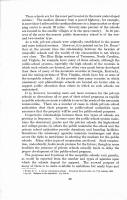 |
| 49 |
049 |
girls of the more backward areas the advantages of a
type of schooling which is either more advanced in character, superior
in quality, or more closely adapted to the peculiar needs of the people
than that provided at public expense. Curricular offerings.—The
programs of education most commonly found in nonpublic schools differ
very little from those ordinarily found in public schools. On the whole
their educational offerings are those established by convention and
tradition. Dr. Dunn 4 summarized this situation in the missionary
schools offering high-school work as follows:
Every secondary school except the John C. Campbell Folk School and
the Asheville Farm School offers a college-preparatory curriculum, but
curricula in agriculture and in home economics are found in only 25 and
50 percent of the schools, respectively. Forty-three percent have not
even one course in agriculture, and 24 percent none in home economics.
On the other hand, 95 percent offer geometry and 95 percent algebra; 73
percent are giving 2 or more years to algebra. Two secondary schools
actually offer trigonometry, while only four give economics or
sociology, or both. Music is provided in 60 percent of the schools, but
Latin is offered in 84 percent, 4 years of Latin being given in 13
percent of the schools. Offerings in science are fairly heavy, every
school giving at least one course, while 18 percent offer 3, 4, or 5
years. History ranks next to English in number of courses offered, 3
years being the mode. Sixty percent of the schools offer from 2 to 4
years of a modern language, usually French, although in 9 percent of the
schools Spanish is offered either with or without another language. In
only one case is this other language German.
However, according to the study quoted, the nonpublic schools provide
many activities, extracurricular and extra-school in character, which
have a marked effect upon the educational and social welfare of the
mountain communities served. The home life provided through boarding
facilities has no doubt greatly improved the tone of living of the
mountain people.
The boarding home is indeed one of the soundest educational agencies
of the missions. The home life provided by the school rather than the
curriculum deserves most of the credit.
[1]
[2]
[3] Contact in all the
aspects of daily living with the amenities of life, as illustrated by
the refined, cultured, and socially-minded teachers and house-mothers in
many of the schools, is an additional educational factor unequalled in
the day schools.5
A number of the nonpublic schools operate farms, dairies, laundries,
and other industrial enterprises. Some schools are making an effort to
develop and promote crafts which are either native to the community or
have possibilities for raising the economic status of the
[1]Religion
in the highlands. Op. cit., pp. 277-283. »Ibid., pp. 280-281.
[2]Religion
in the highlands. Op. cit., pp. 277-283. »Ibid., pp. 280-281.
[3]Religion
in the highlands. Op. cit., pp. 277-283. »Ibid., pp. 280-281.
|
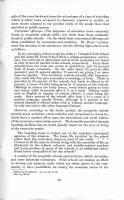 |
| 50 |
050 |
people. Most of the industrial enterprises have as one
purpose the production of commodities needed in the immediate operation
of the school. In a few cases they serve the community also. Earnings
from such industries go into the maintenance of the schools. It is
obvious that both the routine duties connected with running a school,
home, and farm, as well as those connected with the other useful
industries, have possibilities both in the educational growth of the
children touched by them and in the improvement of the social and
economic life of the people. The important thing is, of course, that the
duties connected with such activities be rotated in keeping with sound
educational principles and that the children be not overworked by the
[IMAGE]
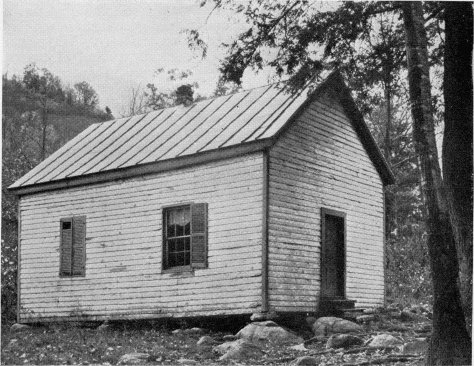
Church in the southern mountains
participation required of them.
Nonschool educational activities.—There are also maintained in the
mountain communities a large number of nonschool educational services.[1]
Usually these services are in the nature of community activities
directly associated with the nonpublic schools. Sometimes, however,
such services as hospitals, home nursing, libraries, agricultural and
home extension activities, and other social welfare activities are
provided at mountain outposts remote from the school
[1]Dr.
Dunn made an effort to locate activities of this type by States and
by counties. Religion in the Highlands. Op. cit. (See appendix.)
|
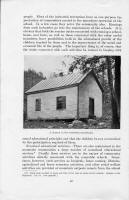 |
| 51 |
051 |
centers. In some centers Sunday schools and similar
religious services are maintained in communities not included in the
regular church organizations. The regular church program is, of course,
also recognized as an important educational force. The presence or
absence of well-developed church services is a subject too large to be
even briefly reviewed here. This problem has been thoroughly studied and
fully reported in other studies.7 In approximately a score of
different communities some effort is made by philanthropic or missionary
enterprise to stimulate activity in handcrafts.8 These crafts are not
only affording opportunity for artistic expression and cultural
development in mountain communities but their products have in many
cases become an important source of income. Considerable social work is
being carried on in more than 60 localities through settlement houses
and community centers maintained by private agencies. Such centers help
to distribute and remodel clothing contributed for the needy. They
serve as repositories for circulating libraries, provide health and
first-aid services, serve as general meeting places for the social life
of the communities in which they are located, and provide other
services. In a number of localities they foster definite instruction in
homemaking and in agriculture-Such services, so important to the more
backward mountain homes, are promoted by philanthropic and missionary
enterprise outside of the program commonly associated with the schools.
The Frontier Nursing Service 9 with headquarters at Hyden, Ky., is an
example of this kind of service. Its major purpose is to prepare trained
nurses and midwives for the mountain communities of Kentucky and the
adjoining States where medical services are inadequate. This
organization maintains hospitals, clinics, nursing centers, and
midwifery schools where mountain people may not only obtain health
services, but training adapted to the peculiar conditions and needs of
the more isolated and destitute mountain homes.
7 Hooker, Elizabeth. Religion in the
Highlands, New York, The Home Mission Council, 1933. The church
situation. In Economic and Social Problems and Conditions in the
Southern Appalachians. Op. cit., pp. 168-82.
8 Nienburg, Bertha M. Potential earning power of
southern mountaineer handcrafts. Washington, Government Printing
Office, 1935. (U. S. Department of Labor, Women's Bureau, No.
128.;
9 Poole, Ernest. Nurses on Horseback.
New York, The Macmillan Co., 1932.
Wilford, M. B. Income and health in remote
rural areas—A study of 400 families in Leslie County, Ky.
Doctor's thesis, Columbia University, 1932.
Buck, Dorothy T. The frontier nursing service. Mountain Life and
Work, vol. 9, January 1934.
|
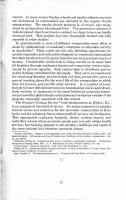 |
| 52 |
052 |
[INDEX OF TABLES] CONTENTS
Page
Foreword___________________________________________________________ vn
Chapter I.
Introduction______________________________________________ 1
The Southern Highlands—A favorite theme of news and
fiction_____ 1
Extent and character of the Southern
Highlands__________________ 3
Ability to support
schools______________________________________ 4
Social and economic
conditions_________________________________ 6
Chapter II. School Conditions in the Southern
Appalachians__________ 9
Plan of the
study______________________________________________ 9
The educational problem in terms of
numbers____________________ 12
Availability and accessibility of schools—A general
view___________ 14
Proportion of children attending
school______________________ 14
Elementary and secondary school
enrollments________________ 15
Area per school in square miles and transportation
expenditures. 17
Some measures of the amount and quality of
schooling 19
Grade levels
attained______________________________________ 19
Length of school term and days
attended__________________________ 21
Illiteracy________________________________________________ 21
Age-grade status of
pupils______________________________________ 22
Qualifications of
teachers__________________________________ 24
Financial measures of educational
opportunities 27
Average annual
expenditures___________________________________ 27
Value of buildings, grounds, and school
equipment_________________ 29
Estimated taxable wealth available for the support of
schools________ 32
Financial aid for schools from State
sources__________________ 32
Human resources as a factor in school
support_____________________ 34
Availability of schools in selected mountain
counties 36
Plan and purpose of this phase of the
study_______________________ 36
Location and distribution of
schools______________________________ 38
Distances children live from
school______________________________ 40
Relationship of school attendance to
availability___________________ 45
Chapter III. Denominational and Independent Nonpublic
Schools. 47
Introductory
statement________________________________________ 47
Types of nonpublic
schools_____________________________________ 47
Curricular
offerings_______________________________________________ 49
Nonschool educational
activities________________________________ 50
FIGURES
I. Location and expanse of the Southern Appalachian
Mountains and the counties selected for special
study _______
3
II. Location and accessibility of schools, 1932,
Lumpkin County, Ga_____ 37
III. Wolfe County, Ky_________________________________________________
39
IV. Macon County, N.
C_______________________________________________ 40
V. Monroe County, Tenn
41
VI. Mercer County, W. Va_________________________________________
43
|
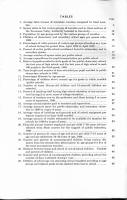 |
